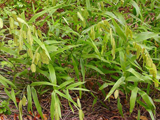Native Plants

Q. Who is Mr. Smarty Plants?
A: There are those who suspect Wildflower Center volunteers are the culpable and capable culprits. Yet, others think staff members play some, albeit small, role. You can torture us with your plant questions, but we will never reveal the Green Guru's secret identity.
Did you know you can access the Native Plant Information Network with your web-enabled smartphone?
Ask Mr. Smarty Plants is a free service provided by the staff and volunteers at the Lady Bird Johnson Wildflower Center.

rate this answer
Monday - June 18, 2012
From: Leander, TX
Region: Southwest
Topic: Xeriscapes, Drought Tolerant, Groundcovers, Shade Tolerant, Grasses or Grass-like, Herbs/Forbs
Title: Ground cover under live oaks
Answered by: Guy Thompson
QUESTION:
I have some areas under Live Oak trees (maybe 200 sq. ft.)that remain bare, in spite of trying Habiturf. Soil is dry, poor and shallow. Can you suggest a living ground cover that would not require major rework of the soil?ANSWER:
I have had the same experience as you, except my bare ground is under deciduous oaks, Quercus texana (Nuttall oak). I am experimenting with several native plants that will survive drought. I'm having pretty good luck with Calyptocarpus vialis (Straggler daisy), Carex planostachys (Cedar sedge), Salvia lyrata (Lyreleaf sage), and Paspalum setaceum (Thin paspalum). Some of the other sedges, such as Carex texensis (Texas sedge) and Carex amphibola (Creek sedge) might do well, although they might need slightly more water than Habiturf. These are all mowable at a height of about four inches. The first four species are common around suburban Central Texas, and I simply transplanted some from other spots in my yard. I also tried Tridens muticus (Slim tridens), but it seems too coarse for a lawn. If a taller grass will fit in, try Chasmanthium latifolium (Inland sea oats), which grows to about two feet in height and does very well in shade.
Images of some of my suggested species are shown below.
From the Image Gallery
More Shade Tolerant Questions
Deer resistant plants for area under grand fir (Abies grandis) in Idaho
July 08, 2010 - What can I plant on a slope under Grand Fir trees in North Idaho, zone 4 - anything deer resistant?
view the full question and answer
Shade tree for cemetery in Wilmington DE
September 13, 2009 - We are looking for a shade tree for a cemetery in Delaware. The tree will be planted only a few feet from some existing gravesites. What trees would you recommend that will not interfere with the ...
view the full question and answer
Native Perennials for Dry Shade in NM
July 06, 2016 - I live in Edgewood, NM at an elevation of about 7,200 ft. It is very dry here and it can get below zero (rarely) in the winter. I have some areas under cedar trees where I have had difficulty gettin...
view the full question and answer
Shade trees for NC
March 22, 2011 - What fast growing non invasive tree would be good to plant in a sub-division that could possibly shade my 2 story house? I would like it to have a tap root system so that it is strong in windy condit...
view the full question and answer
Ground cover for shady area in Maryland
April 27, 2010 - What ground cover grows well on a shady slope with close to surface tree roots?
view the full question and answer
| Support the Wildflower Center by Donating Online or Becoming a Member today. |

